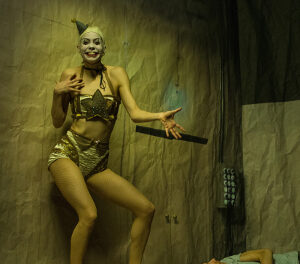Meymandi Concert Hall looks and sounds best when its stage is full of musicians and its seats are full of paying attendees. There was a good deal of that on the afternoon of December 2 when the Triangle Youth Philharmonic, the “senior” orchestra of the Philharmonic Association launched its celebratory winter program, marking the group’s 20th anniversary. Founding Maestro Hugh Partridge conducted, as he has so often during the intervening years. The program was eclectic, consisting of a new work, a second modern work, and two other fine 20th-century works. It’s the sort of program that would be poison at the box office of most mainline orchestras but that on this occasion proved completely satisfying to the enthusiastic audience of family members, friends, advocates of quality music education, and orchestral fans who crave the big sound that only ensembles with 100+ musicians can generate.
The afternoon began with remarks by the current President of the Philharmonic Association, who introduced Dr. Assad Meymandi, in honor of whose mother the venue itself is named. He reminisced about this orchestra’s predecessor, RYSO (the Raleigh Youth Symphony Orchestra), whose founder, Richard Southwick, 94, was on hand to celebrate and be celebrated, too. From a handful of young players — 35 was the number cited — the PA has grown exponentially to encompass, now, close to ten times as many young musicians. That makes the PA and its component groups — the TYP, the Triangle Youth Symphony, the Triangle Youth Orchestra, the Triangle Youth Jazz Ensemble, and several other, smaller performing units — one of the region’s greatest cultural and educational success stories. Bravo!
Maestro Southwick was escorted to the stage to receive a plaque marking his pioneer efforts to forge the first city-wide youth orchestra. The citation that was read is reprinted below, with the kind permission of the PA’s own artistic director.
But it was the music that mattered most, and the program began with a fine new piece, written to celebrate the occasion. It’s by Tom L. Lohr, a composer long based at Meredith College; “Festive Concert Overture” is a substantial (6 minute) curtain-raiser with pleasingly contrasted moods that show off the various sections of the orchestra admirably. From its opening drum rolls to its saucy brass fanfares to its somewhat introspective inner section, this generally optimistic piece successfully filled the need for a new work and concurrently gave the 102 or so young artists yet another world premiere to add to their individual resumes. Lohr was of course on hand to acknowledge the applause and share it with the players.
Joan Tower’s “Made in America” (2004) is a fantasy, sort of, that seems to embody and evoke lots of grand old American music of the past without making direct quotations of any familiar tunes other than “America the Beautiful.” Its appeal rests in its mood and overall optimism, and naturally it’s a very handsomely crafted piece, too. It may well be among the most performed recent American composition, thanks to the patronage of Ford and the involvement of numerous orchestras in the project.
The TYP’s performance was impressive, for the most part, so here’s hoping they’ll play it again fairly soon. There were some minor glitches here and there, but nothing much detracted from the sweep and effectiveness of the music.
After the intermission, John Ilika, Principal Trombone of the NC Symphony, led the TYP Brass Ensemble in Copland’s “Ceremonial Fanfare” (1969), “commissioned,” his publisher’s website tells us, “by the New York Metropolitan Museum of Art in celebration of its centennial year.” It is indeed a stately, ceremonial piece as opposed to a boisterous fanfare à la the “Fanfare for the Common Man.” There were some little problems here, too, but for the most part the young musicians responded well to Ilika’s directions.
The program ended with Stravinsky’s Firebird Suite, given in its 1919 incarnation. The idea of a stage-full of students playing this great score is stimulating, indeed, and they did extremely well as the score unfolded before our ears. The slow sections were richly dramatic and the faster numbers were clearly and cleanly articulated. The dynamics were nicely shaded, and at the end the place erupted with well-deserved applause and cheers.
Come join in the anniversary celebrations when they continue on May 4, 2008. See https://www.cvnc.org/calendar/series/triangle/PhilharmonicAssoc.html for details.
“It is very fitting that, on the 20th anniversary of the Triangle Youth Philharmonic, the Philharmonic Association honor the man who was the motivating force behind instrumental music in Raleigh for decades: Richard E. Southwick.
“Before coming to Raleigh over 50 years ago, Dick was already an experienced music educator. With his belief that public school music programs were the foundation of every aspect of music performance in our community, he set to work developing an award-winning instrumental program at Broughton High School.
“Soon he was teaching at the other two Raleigh high schools — Sanderson and Enloe. His decision to bring together the best musicians from these programs [to] form the Raleigh Youth Symphony Orchestra has led to the youth orchestra program you see on this stage today. For that, and all your contributions to our community, Dick, we will be forever grateful.”
– Hugh Partridge, 12/2/07












